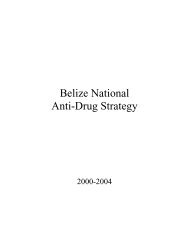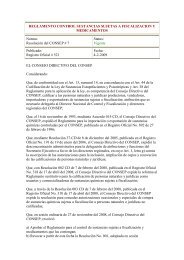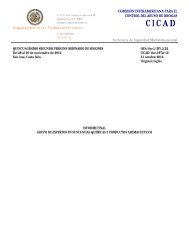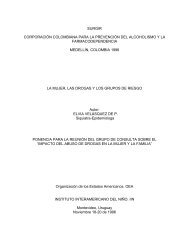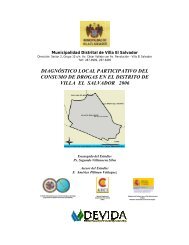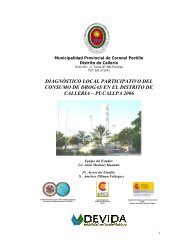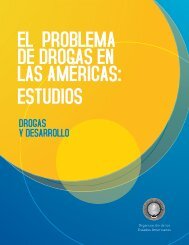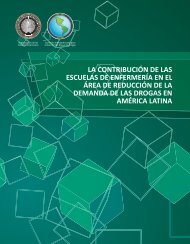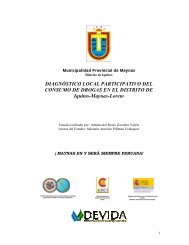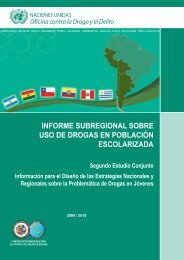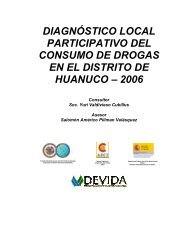Neurociencia del consumo y dependencia de sustancias psicoactivas
Neurociencia del consumo y dependencia de sustancias psicoactivas
Neurociencia del consumo y dependencia de sustancias psicoactivas
- No tags were found...
You also want an ePaper? Increase the reach of your titles
YUMPU automatically turns print PDFs into web optimized ePapers that Google loves.
NEUROCIENCIA DEL CONSUMO Y DEPENDENCIA DE SUSTANCIAS PSICOACTIVASFerentzy P (2001) From sin to disease: differences and similarities between pastand current conceptions of chronic drunkenness. Contemporary Drug Problems,28:363–390.López AD, Collishaw NE, Piha T (1994) A <strong>de</strong>scriptive mo<strong><strong>de</strong>l</strong> of the cigaretteepi<strong>de</strong>mic in <strong>de</strong>veloped countries. Tobacco Control, 3:242–247.Mackay J, Eriksen M (2002) The tobacco atlas. Ginebra, Organización Mundial<strong>de</strong> la Salud.Medina-Mora E y colab. (2001) Patterns of alcohol consumption and relatedproblems in Mexico: results from two general population surveys. En: DemersA, Room R, Bourgault C, editores. Surveys of drinking patterns and problems inseven <strong>de</strong>veloping countries. Ginebra, Organización Mundial <strong>de</strong> la Salud: 13-32.Murray CJ, López AD (1996) Global health statistics. Global bur<strong>de</strong>n of disease andinjury series. Vol. 2. Ginebra, Organización Mundial <strong>de</strong> la Salud.Mustonen H, Beukes L, Du Preez V (2001) Alcohol drinking in Namibia. En:Demers A, Room R, Bourgault C, editores. Surveys of drinking patterns and problemsin seven <strong>de</strong>veloping countries. Ginebra, Organización Mundial <strong>de</strong> la Salud:45-62.Obot IS (2001) Household survey of alcohol use in Nigeria: the MiddlebeltStudy. En: Demers A, Room R, Bourgault C, eds. Surveys of drinking patternsand problems in seven <strong>de</strong>veloping countries. Ginebra, Organización Mundial <strong>de</strong> laSalud: 63-76.Rehm J y colab. (2002) Alcohol as a risk factor for bur<strong>de</strong>n of disease. OrganizaciónMundial <strong>de</strong> la Salud, manuscrito inédito.Room R (2001) Governing images in public discourse about problematic drinking.En: Heather N, Peters TJ, Stockwell T, eds. Handbook of alcohol <strong>de</strong>pen<strong>de</strong>nceand alcohol-related problems. Chichester, Wiley: 33–45.Room R y colab. (1996) WHO cross-cultural applicability research on diagnosisand assessment of s use disor<strong>de</strong>rs: an overview of methods and selected results.Addiction, 91:199–220.Room R y colab. (2002) Alcohol and the <strong>de</strong>veloping world: a public health perspective.Helsinki, Fundación Finlan<strong>de</strong>sa para los Estudios sobre el Alcohol.UNODCCP (2002) Global illicit drug trends 2002. Nueva York, NY, EstadosUnidos, Oficina <strong>de</strong> las Naciones Unidas para el Control <strong>de</strong> Drogas y laPrevención <strong><strong>de</strong>l</strong> Delito.Banco Mundial (1999) Curbing the epi<strong>de</strong>mic: governments and the economics oftobacco control. Washington, DC, Estados Unidos, Banco Mundial.OMS (1992) Clasificación CIE-10 <strong>de</strong> trastornos mentales y <strong>de</strong> la conducta: <strong>de</strong>scripcionesclínicas y criterios diagnósticos. Ginebra, Organización Mundial <strong>de</strong> la Salud.OMS (1999) Global status report on alcohol. Ginebra, Organización Mundial <strong><strong>de</strong>l</strong>a Salud.WHO (1994) Lexicon of alcohol and drug terms. Ginebra, Organización Mundial<strong>de</strong> la Salud.OMS (2002) Reporte mundial <strong>de</strong> la salud 2002. Ginebra, Organización Mundial<strong>de</strong> la Salud.18




